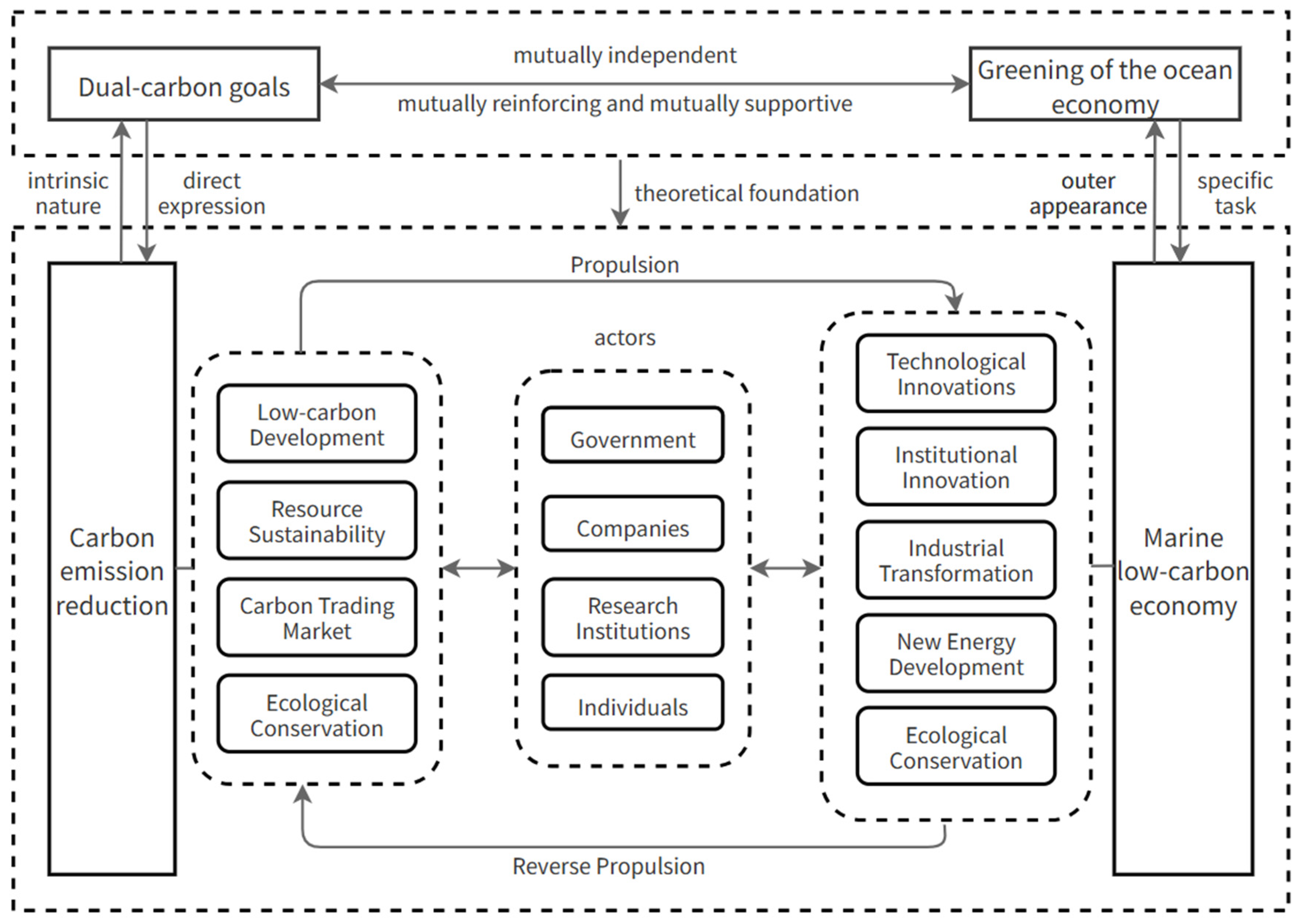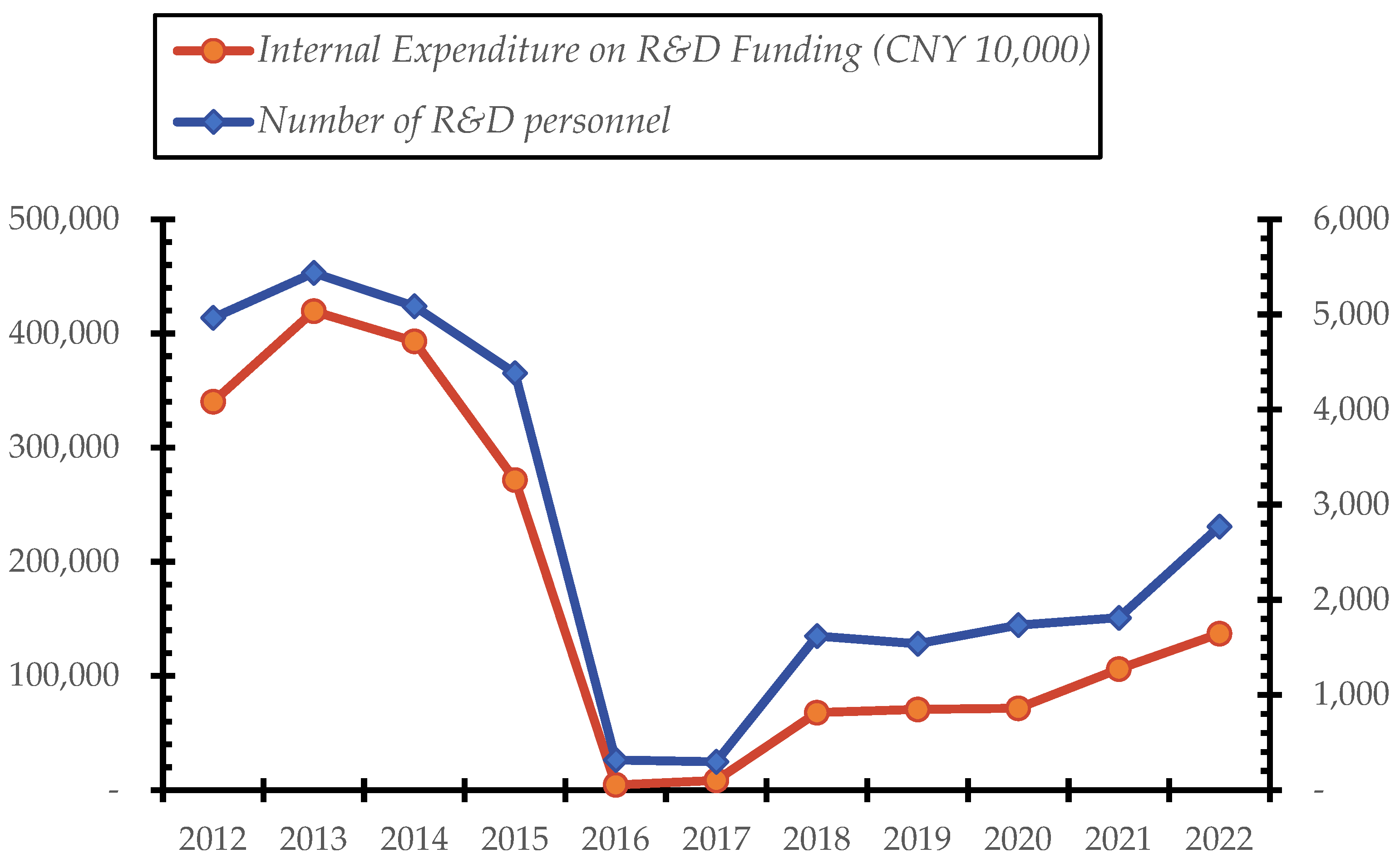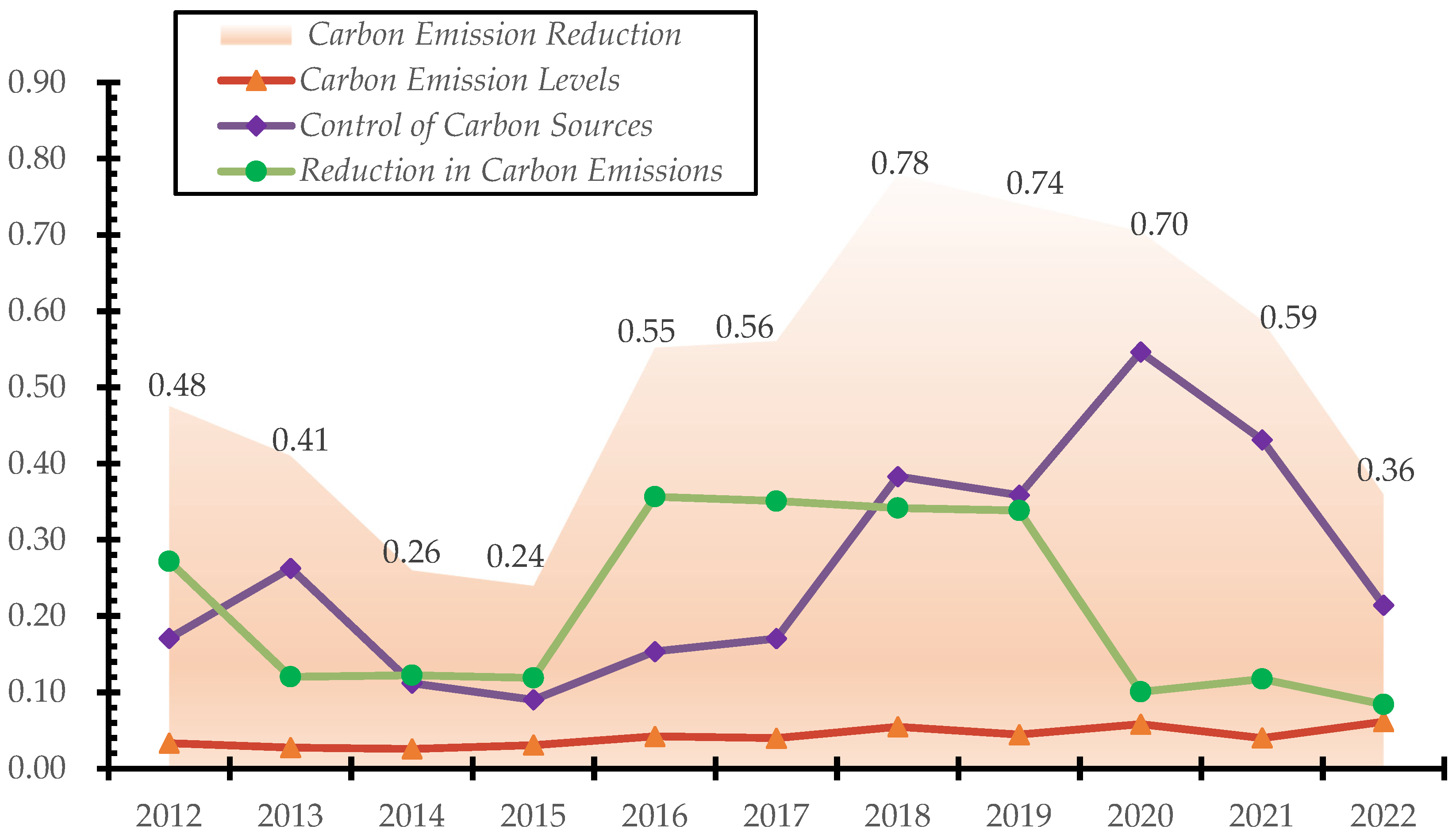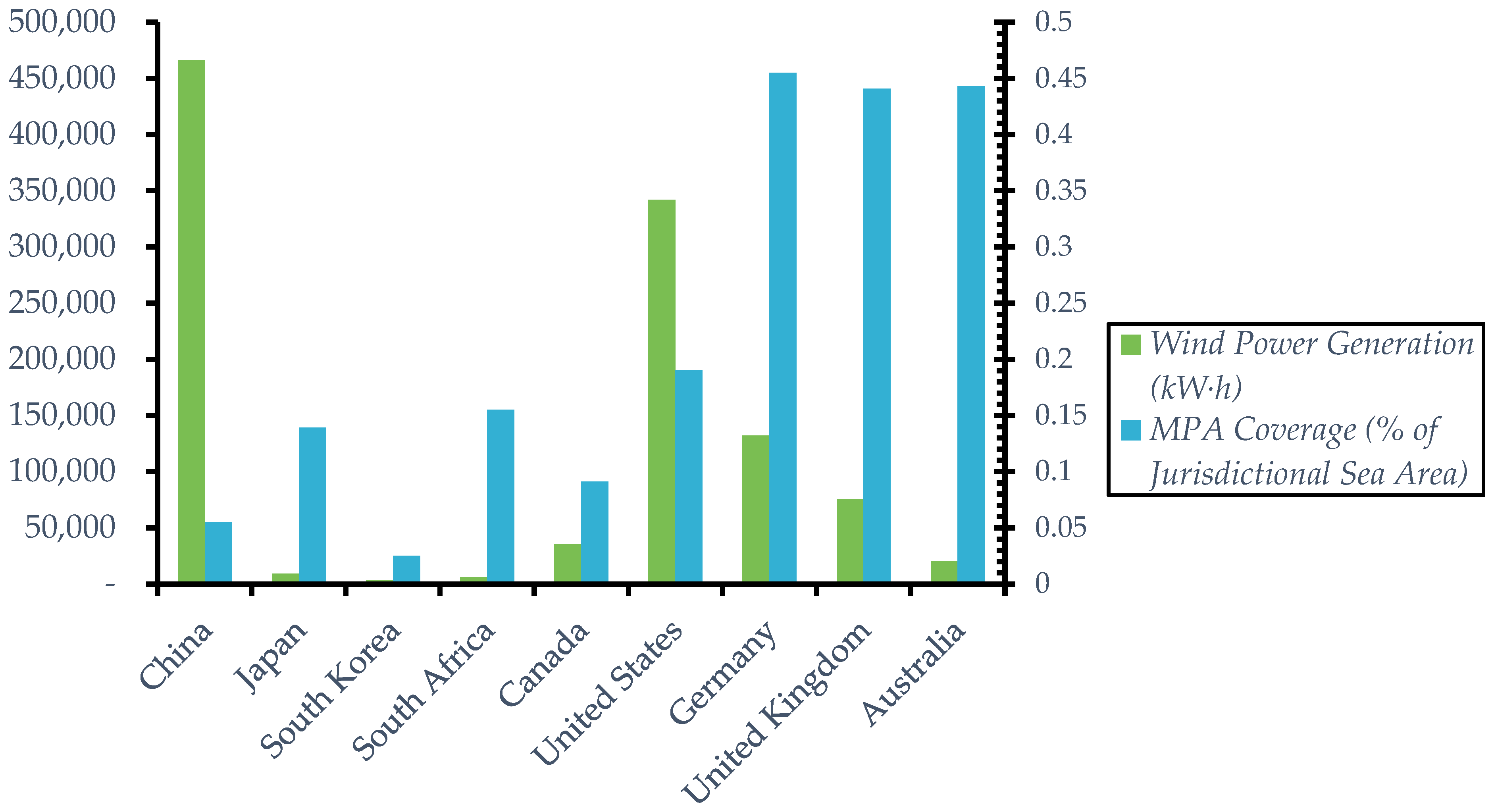The coupling coordination analysis reveals significant potential for improving the synergy between the two systems. In order to develop targeted recommendations, key internal and external influencing factors must be identified, and the situations in different coastal regions of China should be discussed. Additionally, successful international experiences should be referenced to inform improvements. Therefore, this section will address these matters.
5.1. Sensitivity Analysis
To identify key internal influencing factors and develop targeted policies, a sensitivity analysis is necessary. Through the use of one-factor sensitivity analysis, core sensitive factors can be identified, providing a basis for prioritizing policy adjustments. This study uses the one-factor perturbation method to quantify the marginal contributions of each indicator to the coupling coordination degree, identifying key indicators affecting the coordination level between the two systems. A perturbation of ±20% was applied to 18 standardized indicators, and the sensitivity coefficient
was calculated using Formula (15):
where
D represents the coupling coordination degree, and
denotes the standardized value of the indicator. All the analyses were implemented in Python 3.10, with a perturbation step size of 5%, using 2022 data as the baseline. The results are shown in
Figure 6.
The following conclusions can be drawn from the sensitivity analysis results. First, the carbon reduction system dominates in terms of its contribution to the coupling coordination degree. X16 (proportion of fossil energy consumption) shows the highest sensitivity (0.442), directly reflecting the driving force of energy structure transformation on carbon emission reduction. X18 (total wetland area) ranks second in terms of sensitivity (0.339), as expanding the wetland area, a crucial carbon sink, can significantly enhance system coordination.
Second, the primary driving factors for the marine low-carbon economy are offshore wind power capacity and marine protected areas. The sensitivity of X4 (newly installed offshore wind power capacity) is 0.122, indicating significant marginal benefits from new energy infrastructure. X10 (marine protected area) shows a sensitivity of 0.156, suggesting that ecological protection indirectly promotes the low-carbon economy through enhanced carbon sink capacity.
Finally, regarding technological innovation and industrial transformation, X1 (proportion of low-carbon industries) shows a sensitivity of 0.101, reflecting the long-term effects of industrial structure adjustment. X5–X9 (R&D-related indicators) show sensitivities ranging from 0.052 to 0.115, demonstrating the cumulative nature of technological innovation.
Reviewing high- and low-sensitivity indicators is critical for policymaking (
Table 6). The policy implications of high-sensitivity indicators include: First, prioritize regulating X16 and X18 through policy instruments like carbon trading and carbon taxes to reduce fossil energy consumption (X16). Simultaneously, strengthen wetland conservation and restoration to expand the wetland area (X18), enhancing the ecological carbon sink capacity. Second, accelerate offshore wind power construction (X4), as rapid improvements can generate significant coordination benefits and facilitate the energy transition. Third, enhance technological innovation and talent cultivation (X5) through policy incentives like research subsidies and tax benefits to attract high-quality professionals in regard to marine low-carbon technology R&D. Fourth, strengthen marine ecological protection (X10) by expanding protected areas and incorporating more ecologically vulnerable zones to improve the marine carbon sink capacity.
Optimization directions for low-sensitivity indicators are as follows: First, X2 (growth rate of marine low-carbon industries) shows minimal sensitivity (0.023), possibly due to it approaching saturation in terms of the current growth rates, necessitating the exploration of new models (e.g., blue carbon finance) to unlock incremental development potential. Second, X8 (quantity of scientific papers), with a sensitivity of 0.052, suggests shifting the focus from quantity to quality could be valuable, while strengthening the industry–academia–research translation of relevant insights.
China’s current policies regulating X16 and X18, the most sensitive indicators, have achieved preliminary progress, but they face persistent challenges. While pilot emissions trading schemes (ETSs) target fossil energy consumption (X16), their implementation remains limited: only select maritime sectors (e.g., shipping and marine carbon sinks) are included in some regional markets [
35], compounded by underdeveloped trading mechanisms and regulatory frameworks [
36], which dilute market incentives. Accelerating the integration of maritime industries into the national carbon market and advancing fossil energy substitution through policy tools like carbon quota trading and carbon taxes are crucial. Regarding wetland conservation (X18), despite prioritizing wetland area expansion, weaknesses in the ecological compensation mechanisms and monitoring systems persist [
37]. To strengthen ecological protection, wetland restoration projects should incorporate performance-linked compensation mechanisms, directly aligning fiscal transfer payments with measurable outcomes, such as the amount of restored wetland area and carbon sequestration efficiency, to enhance policy effectiveness.
5.2. Model Significance Tests
The CCD model quantifies the interaction level between the two systems, revealing the degree of coordination in their relationship. According to
Figure 4, the coupling coordination degree between the two systems fluctuates between “primary coordination–close to imbalance–intermediate coordination”. To confirm that this fluctuation represents a genuine pattern rather than random variations, a statistical significance test is needed. However, the small sample size limits the effectiveness of traditional t-tests and linear least squares regression [
38]. The Bootstrap method, which resamples the original data to estimate the distribution of the statistics, provides a direct estimate of the data distribution without relying on hypothesis testing, making it particularly effective for studies involving a small data sample [
39]. Therefore, this paper employs the Bootstrap method [
40] and Block Bootstrap method [
41] for hypothesis testing. The hypotheses are formulated as follows:
H2: D ≤ 0.4 (the coupling coordination degree between the two systems is below the threshold of being on the verge of dysfunction);
H3: D > 0.4 (the coupling coordination degree significantly exceeds the mild imbalance level).
Through 1000 resampling iterations, both standard Bootstrap distributions and Block Bootstrap distributions (block size = 3) were generated to compute 95% confidence intervals and
p-values (see
Table 7).
The Bootstrap test results show that the lower bounds of the 95% confidence intervals for all the years exceed 0.473, indicating that the true coupling coordination degree, D, is unlikely to fall below 0.473 at the 95% confidence level. All the p-values are less than 0.001, confirming that none of the Bootstrap resamples produced a D value of ≤ 0.4, indicating high statistical significance.
To account for potential temporal dependencies in the D values across consecutive years, the Block Bootstrap method was applied to handle the time series effects. The results show that the lower bounds of the 95% confidence intervals for all the years exceed 0.431, with all the p-values being below 0.01. This confirms that the true D value is significantly above 0.431, even after accounting for temporal dependences.
By preserving the time series block structure, the Block Bootstrap method rigorously addresses temporal autocorrelation effects. Compared to the standard Bootstrap method, the Block Bootstrap method yields slightly wider confidence intervals, yet all the p-values remain highly significant (p < 0.01), further validating the model’s robustness.
Both methods reject
H2, showing statistically significant coupling coordination between the marine low-carbon economy and carbon reduction systems, with the coordination levels consistently above the “near imbalance” threshold. These conclusions align with the coupling coordination results presented in
Table 4.
5.3. Analysis of Regional Heterogeneity
To reveal the regional heterogeneity of marine low-carbon economy development and carbon reduction in China’s coastal regions, this study employs the K-means++ clustering algorithm, based on 2022 data from 11 coastal provinces in China, conducting cluster analyses across three dimensions: economic scale, resource endowment, and industrial structure. The K-means++ clustering algorithm [
42], an improved version of the K-means algorithm, uses a probabilistic centroid initialization strategy to reduce the sensitivity to the initial values. This enhancement increases the probability of converging to superior solutions, making it suitable for high-dimensional data. This study applies Z-score standardization to eliminate dimensional effects, sets the number of clusters to 2 for all three dimensions, and limits the maximum iteration count to 20 to ensure stable algorithm convergence. The final classification results are obtained by combining the clustering outcomes from the three dimensions (
Table 8). The variable selection criteria are as follows:
Economic scale: The gross ocean product and per capita GDP of the coastal provinces are selected to reflect the regional marine economy output and the residents’ economic welfare;
Resource endowment: The total wetland area (representing blue carbon resources), the cumulative installed offshore wind power capacity (representing wind energy resources), the number of marine development and research institutions (representing the agglomeration of technological resources), and port cargo throughput (representing logistics and shipping resources) are chosen. Variable selection primarily relies on the sensitivity analysis results (see
Table 6), prioritizing high-sensitivity indicators or related variables. Ports are included as a critical coastal resource due to their association with the high-sensitivity indicator “proportion of fossil energy consumption in marine industries (X16)”, given that the shipping industry predominantly relies on traditional fuels;
Industrial structure: The proportion of marine tertiary industries is selected to characterize the advanced level of the marine economy structure.
1. High Economy–High Resources–High Structure
Guangdong Province has a large marine economy, strong resource endowment, and a high proportion of marine tertiary industries. Its marine gross domestic product ranks first in the country, with leading port cargo throughput and offshore wind power capacity. The proportion of marine tertiary industries is 64.9%. In 2022, Guangdong had 38 marine development and research institutions, second only to Shandong, highlighting strong low-carbon technology R&D capabilities in the region. Guangdong could establish an international marine low-carbon technology R&D center to advance the industrialization of offshore wind-to-hydrogen technologies. Additionally, it could develop high-end service sectors like marine finance and marine big data to increase the value added by the tertiary industry.
2. High Economy–High Resources–Low Structure
Jiangsu and Shandong Provinces have substantial marine economic output and strong resource endowments, but face challenges in regard to their traditional industrial structures. In 2022, their marine gross domestic products ranked second and third in the country. Regarding the relevant resources, Jiangsu leads in terms of total wetland area and offshore wind power capacity, while Shandong’s port cargo throughput reached 1890.36 million tons, the highest in northern China. However, the proportions in terms of marine tertiary industries in both provinces are 55.8% and 50.7%, respectively, with heavy reliance on traditional sectors like marine transportation, leading to significant carbon reduction pressures. To facilitate the low-carbon transition, they could develop integrated “offshore wind power + energy storage” bases to replace fossil fuels. Carbon tax reductions for marine equipment manufacturers and intelligent upgrades should also be prioritized.
3. High Economy–Low Resources–High Structure
Shanghai has a highly developed economy and advanced marine industrial structure, but faces ecological resource constraints. In 2022, its total wetland area was 71,400 hectares, its marine protected areas covered 10 km2, and its offshore wind power capacity was 1004.9 MW, significantly lower than Jiangsu and Guangdong. The wetland area, offshore wind power capacity, and marine protected areas are high-sensitivity indicators affecting the degree of coupling coordination between the “marine low-carbon economy–carbon reduction” and require urgent attention. Recommendations include establishing a wetland carbon sink trading platform in the Yangtze River Estuary, integrating mangrove restoration into carbon markets, and accelerating offshore wind farm construction.
4. High Economy–Low Resources–Low Structure
Tianjin, Zhejiang, and Fujian Provinces have developed economies, but weaker resource endowments than high-resource provinces like Shandong and Guangdong, coupled with lagging low-carbon industrial transitions. In 2022, their per capita GDP exceeded CNY 120,000, yet the average proportion of marine tertiary industries was 55.0%, with continued reliance on traditional port industries, leading to carbon reduction pressures. Zhejiang and Fujian, with their long coastlines, should expand offshore wind farms and increase investments in low-carbon technology R&D. Green port upgrades (e.g., Tianjin Port, Ningbo-Zhoushan Port) and clean fuel adoption are critical.
5. Low Economy–Low Resources–High Structure
Guangxi and Hainan Provinces have abundant ecological resources, but weak economic foundations, with industrial structures focused on eco-services. Their resource profiles include abundant ecological resources, but limited wind energy. Hainan has a total wetland area of 121,600 hectares, with its marine protected areas ranking first nationally, while Guangxi accounts for 33.9% of China’s mangrove area. Both provinces exhibit strong carbon sequestration capacity and low carbon emission pressures due to service-oriented industries. However, their offshore wind power development started late, with grid-connected projects becoming operational only in 2024. To leverage their ecological advantages, they could develop blue carbon tourism products (e.g., “mangrove eco-tourism”) and accelerate offshore wind projects to boost energy transitions.
6. Low Economy–Low Resources–Low Structure
Hebei and Liaoning Provinces face both economic and resource disadvantages, with industrial structures worsening the carbon reduction pressures faced in these regions. In 2022, their average marine gross domestic product was CNY 375 billion, indicating small-scale marine economies. Resource limitations include limited offshore wind power capacity and insufficient technological resources. Industrially, both rely on high-pollution sectors, such as steel and petrochemicals. To facilitate low-carbon transitions, they should increase funding and talent incentivization policies for marine research institutions, promote R&D and the application of low-carbon technologies, and expand offshore wind projects to replace traditional fossil fuels in relevant industries, in order to reduce the carbon reduction pressures.
5.4. Analysis of External Factors
This study examines the factors influencing the degree of coupling coordination between marine low-carbon economy development and carbon reduction, selecting marine technological innovation, compulsory environmental regulation, labor productivity, marine industrial structure, ecological pollution, and carbon market trading as external factors. The grey relational analysis method is used to assess the correlation between these factors and the degree of coupling coordination between the “marine low-carbon economy–carbon reduction”.
Marine Technological Innovation (MI): Represented by the annual number of marine patent applications accepted. Marine technological innovation can directly or indirectly reduce the carbon emission intensity in marine industries and promote green structural transformation through the development and application of marine technologies.
Compulsory Environmental Regulation (CER): Measured as the ratio of completed industrial pollution control investment to the regional GDP in coastal provinces. Environmental regulation compels enterprises to adopt clean production technologies through the use of policy constraints, reducing industrial pollution emissions [
43], thereby indirectly optimizing the synergy between the marine low-carbon economy and carbon reduction. A higher ratio of pollution control investment to GDP indicates stronger policy enforcement, increasing non-compliance costs for enterprises and incentivizing their transition to low-carbon production models.
Labor Productivity (LP): Defined as the average labor productivity in coastal regions, calculated as the ratio of the total GDP in 11 coastal provinces to their total employed population. High labor productivity typically accompanies technological advancement and management optimization, driving economic structural transitions toward high value-added activities and low energy consumption [
44], thereby reducing energy intensity.
Marine Industrial Structure (MS): Represented by the proportion of tertiary industries in regard to China’s marine gross domestic product. An increased tertiary industry share reduces the marine economy’s reliance on resource-intensive industries, thereby lowering carbon emissions. The “structural dividends” from industrial structure upgrading promote service-oriented economic development, which can effectively facilitate the entry of innovative new enterprises, thereby enhancing carbon emission reduction effects [
45].
Ecological Pollution (HAB): Indicated by the annual frequency of red tide occurrences. Frequent red tides reflect marine ecosystem degradation, potentially weakening marine carbon sink capacity and exacerbating carbon emission pressures. Ecological pollution indirectly impacts carbon reduction system efficiency by reducing phytoplankton carbon sequestration efficiency [
46].
Carbon Market Trading (ETS): Measured according to the carbon emission allowance transaction volume. Carbon trading assigns a price to carbon emissions through market mechanisms, incentivizing enterprises to proactively reduce emissions and invest in low-carbon technologies. Carbon price signals guide resource allocation toward low-carbon sectors, strengthening market-driven momentum in regard to synergistic developments between the two systems [
47].
The results of the grey relational analysis are shown in
Table 9.
The marine industrial structure (MS) has the highest relational degree (0.9021), indicating that increasing the tertiary industry share is the core driver for optimizing the degree of coordination between the two systems. This aligns with the “structural dividends” theory, showing that industrial upgrading significantly promotes low-carbon transitions by reducing the level of energy dependency.
Marine technological innovation (MI, 0.8932) and labor productivity (LP, 0.8865) rank second and third, respectively, supporting the “technology-efficiency dual-driven hypothesis”. Technological innovation directly reduces carbon emissions, while efficiency gains indirectly lower carbon intensity by increasing production efficiency.
Compulsory environmental regulation (CER, 0.8338) has a limited impact on coordination enhancement, likely due to the high short-term costs of enterprises’ passive emission reduction activities. Ecological pollution (HAB, 0.8523) reflects systemic feedback on the negative effects of frequent red tides on the carbon sink capacity, although the long-term effectiveness of ecological restoration requires further observation.
Carbon market trading (ETS, 0.7884) has the lowest relational degree, indicating that current carbon market mechanisms are insufficiently activated. Potential causes include low carbon prices and limited industry coverage [
48]. Enhancing market vitality through expanded quota auctions and the integration of financial instruments is recommended.
5.5. International Comparative Analysis
Many countries have integrated low-carbon development into the growth of their marine economies. To understand China’s successes and shortcomings in this area and gain from international experience, it is necessary to compare highly sensitive indicators affecting the degree of coupling coordination between the two systems based on the experience in other countries. Based on the sensitivity analysis results from
Section 5.1 (
Table 6), offshore wind power, marine protected area (MPA) coverage, and wetland area are identified as high-sensitivity factors influencing the degree of coupling coordination between the “marine low-carbon economy–carbon reduction”. This section compares international data on these aspects to identify gaps in China’s marine low-carbon economy development and its progress toward carbon peaking and neutrality goals.
In terms of offshore wind power, by 2022, China’s cumulative installed offshore wind capacity exceeded 30 GW, accounting for over 50% of the global total. Its annual wind power generation surpassed 450,000 GWh, ranking first globally, far exceeding traditional leaders like the UK and Germany (
Figure 7, data sourced from the China Marine Economic Statistical Yearbook 2023). These achievements stem from large-scale development and policy incentives, such as fixed feed-in tariffs for non-fossil energy (e.g., wind and solar) and mega projects like the Yancheng (Jiangsu) and Yangjiang (Guangdong) wind power bases.
In terms of marine protection, as of 2022, China’s MPA coverage constituted 5.5% of its jurisdictional sea area, significantly lower than Australia (44.3%), Canada (9.1%), and South Africa (15.5%) (
Figure 7), with significant gaps compared to some EU member states.
Mangroves, critical blue carbon resources with robust carbon sequestration capacity, currently cover approximately 30,000 hectares in China, representing less than 0.5% of the global total. China’s mangrove area declined from 50,000 hectares in the 1950s to 22,000 hectares by 2000, but recovered to 30,000 hectares by 2019 through restoration efforts. While China has mitigated degradation over these three decades and achieved measurable restoration, its techniques and strategies still require refinement. Indonesia offers valuable lessons for China. Indonesia, the country with the world’s largest mangrove area, offers valuable lessons through its community-based mangrove management (CBMM) model, implemented since the 1980s. This approach emphasizes international collaboration, community engagement, and sustainable practices to enhance biodiversity and coastal resilience [
49]. For example, in regard to community participation, Indonesia has integrated the CBMM model with economic activities through eco-tourism in the Langkat and Deli Serdang regions of North Sumatra. This approach not only protects the mangrove ecosystem, but also enhances the economic benefits for local communities [
50]. China could adopt similar mechanisms in regions with abundant blue carbon resources but underdeveloped economies, such as Guangxi and Hainan. By developing “blue carbon tourism”, China could encourage residents to participate in the protection and restoration of blue carbon resources, such as mangroves, while simultaneously driving regional economic development.
Relative to other coastal nations, China has achieved significant advantages in regard to offshore wind power, yet faces certain challenges, such as the inadequate development of marine protected areas and immature restoration technologies for blue carbon ecosystems. For the restoration of blue carbon resources, such as mangroves, China can adopt Indonesia’s mangrove recovery model, which emphasizes collaboration with international organizations and community participation. Particularly, China could refer to the approach that combines eco-tourism with community participation and develop “blue carbon tourism” in regions such as Guangxi and Hainan. Strengthening marine protected area construction and blue carbon restoration will foster coordinated development between the marine low-carbon economy and carbon reduction, thereby advancing the progress toward carbon peaking and carbon neutrality.














